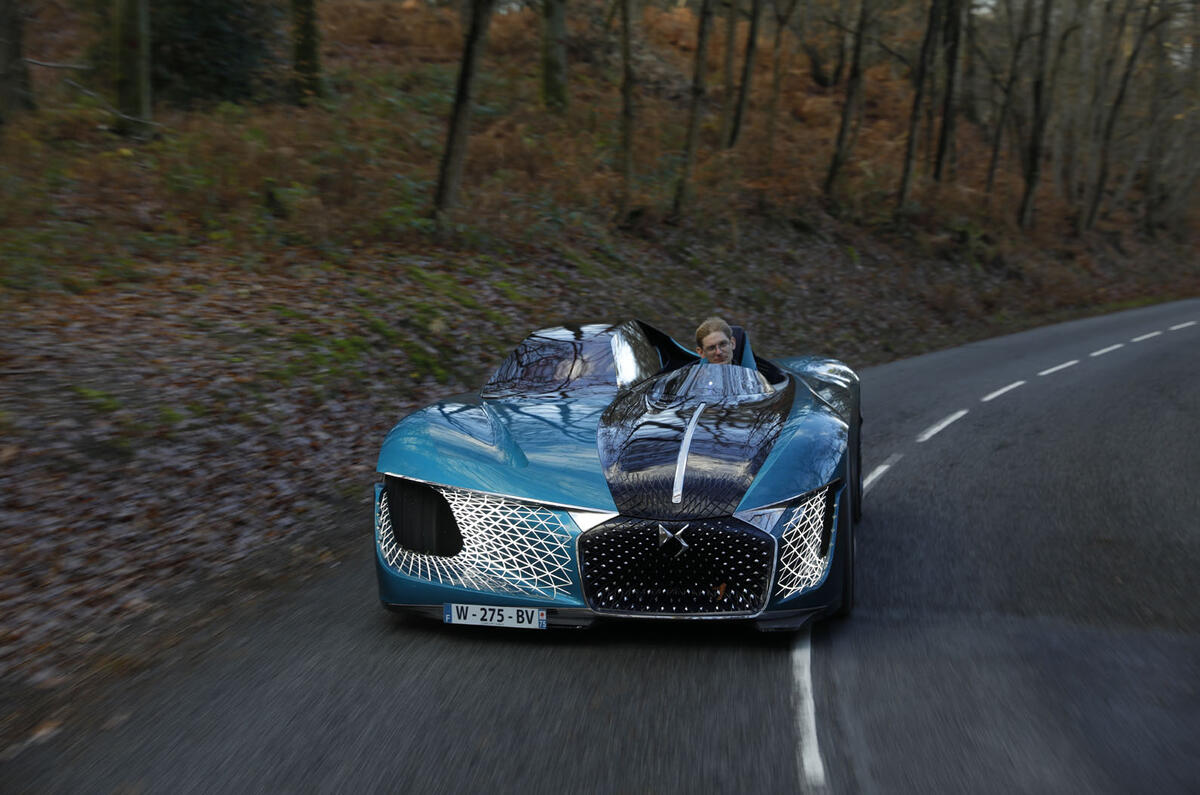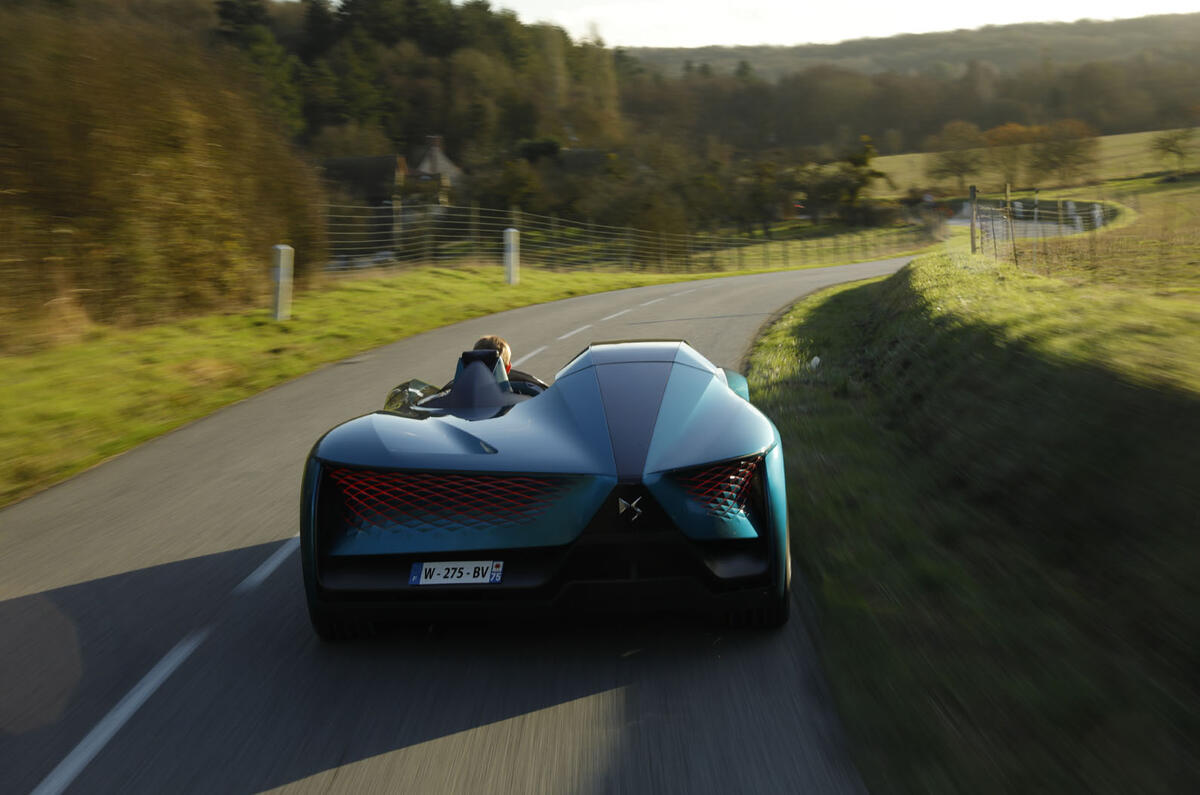For an electric concept car, DS X E-Tense offers a visceral experience for its driver – one that reflects both its unusual inspiration and racing car underpinnings.
The X E-Tense, DS’s vision of what motoring could look like in 2035, is a three-seat machine based on a DS Formula E single-seater designed to offer two contrasting experiences. On one side it features an open-top cockpit designed to offer wind-in-hair motoring and enhanced driver engagement. Next to that is a spacious passenger cabin featuring a reclining seat and a footstool that can double as a short-term third seat.
The idea is that the owner of an X E-Tense can choose between an engaged driving experience, or engage autonomous mode and be driven along in comfort and luxury.
According to DS design director Thierry Metroz, the contrasting experiences offered by the asymmetrical layout were styled after a motorcycle sidecar. “With a sidecar you have a driver’s side dedicated to pleasure and driving sensation, which is completely open to the surroundings and nature and you’re connected to your surroundings, and in the other part you’re connected in a luxury cocoon,” said Metroz.
“So the driver can be thrilled in the open wind and real driver engagement, or you can sit in the passenger side with a nice Hi-Fi system and a coffee machine.”
During Autocar’s time with the X E-Tense, we were able to sample both sides of the car. In the concept the passenger side wasn’t as polished as Metroz imagines a version would be in 2035, so there was no coffee machine - but there was a comfy seat and plenty of space to relax in.
Unusually, the passenger cabin also features a see-through floor which, combined with the large bubble window and low roofline, ensures you still have a pleasant sensation of motion while reclined in it. The see-through floor does reveal just how low the X E-Tense’s ground clearance is which, while not an issue for a passenger, does add to the challenge of driving it.
It’s the driver’s side of the X E-Tense where the most interest lays - and where the the car’s racing car underpinnings really show.
The open cockpit feels much like a single-seater racing car cockpit, from the sharply reclined seat to the small steering wheel and minimal switches. It also really focuses your attention forward and makes you feel you’re driving something far smaller than you are.
Underneath, the X E-Tense’s running gear is all based on a Formula E machine, with the motors at the front and battery at the rear, ensuring it can run much lower than an electric car with under-floor batteries. It also features stiff Formula E suspension and firm steering.
According to DS, the intention is for the X E-Tense’s two electric motors to produce 536bhp (or 1341bhp in limited-time circuit mode), but the concept didn’t seem to offer quite so much power. It still had plenty for a one-off prototype, and on open French country roads could happily reach 50mph without too much struggle.
That was fast enough for the bracingly cold French wind to really bite, and to really hear the surprisingly loud whine from the two Formula E motors. The X E-Tense certainly doesn’t play to the stereotype of autonomous electric cars as silent, sterile, emotion-free mobility devices.
At speed, with the cold wind, the comfortable, cocooned passenger compartment begins to feel very tempting. But then you reach some flowing corners and the X E-Tense’s focused driving position, stiff ride and firm steering draw you in.
It feels like you’re driving a single-seater – unsurprising, given the concept is effectively built on the platform of one – which can make it somewhat unnerving when you realise there’s a substantial passenger area to your right. I was frequently reminded of that whenever I turned right, to discover my view blocked by the passenger area’s large perspex canopy.
The sheer width of the X E-Tense, combined with the lack of wing mirrors, stiffly sprung suspension and incredibly low ride height, meant that it isn’t ideally suited to public roads. Driving through small French towns meant nervously dodging low kerbs, and traversing speed bumps required the help of a DS employee guiding me.
Still, such issues reflect the root the concept was built on, rather than the potential of the concept itself. And while it’s hard to sit in 2019 and imagine cars like it will really be on the roads in 2035, the X E-Tense offers a refreshingly different vision for future cars: one in which driver involvement is as important as space and comfort.
Read more
DS reacts to 'boring' concept cars
Audi E-tron GT concept 2018: first drive of electric sports saloon

























Join the debate
Add your comment
Terrible irrelevant design
Leaving to one side whether this is ugly, unbalanced and impractical to ever build (which it is), design should be about solving a problem. What problem is this intended to solve? How to package car mechanics more badly? How to reduce visibility for occupants? Utterly pointless as no aspect of this design is needed or desirable - a wasted opportunity to truly deliver multiple experiences to various occupants or investigate alternative packaging options that electrification delivers.
Huge.......
Having seen pics before of the concept, seeing it in real World situations, it looks massive!